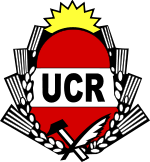Cambiemos
Cambiemos Cambiemos | |
|---|---|
|
| |
| Leader | Mauricio Macri |
| Deputy Leaders | Ernesto Sanz, Elisa Carrió |
| Founded | June 15, 2015 |
| Ideology |
Liberalism[1] Conservatism[2] Developmentalism[3] |
| Political position | Big tent[4][5][6][7] |
| Members |
Republican Proposal, Radical Civic Union, Civic Coalition ARI |
| Chamber of Deputies |
89 / 257 |
| Senate |
15 / 72 |
| Governors |
5 / 24 |
| Website | |
|
cambiemos | |
Cambiemos (Spanish pronunciation: [kamˈbjemos]; Spanish for "Let’s change") is an Argentine big tent[8][9][10] political coalition created in 2015. It is composed by the Republican Proposal (PRO), the Radical Civic Union (UCR), and the Civic Coalition (CC). These three parties respectively nominated Mauricio Macri, Ernesto Sanz, and Elisa Carrió as their representatives in the August 2015 primary elections, held to choose which candidates would finally run in the 2015 presidential election on 25 October.[11]
On 9 August 2015 Mauricio Macri was elected as the candidate who would represent Cambiemos in the presidential election; on 22 November he won the presidential election.
Creation
Initially, the pre-candidates Mauricio Macri, Daniel Scioli, and Sergio Massa had a triple tie in the polls for the 2015 presidential election. The other parties created a political coalition, the Broad Front UNEN. Elisa Carrió, leader of the Civic Coalition, left UNEN and joined a coalition with Macri's Republican Proposal instead. Both of them would run in the primary elections. The Radical Civic Union was divided: Ernesto Sanz proposed to join Macri as well, and Julio Cobos proposed to stay in UNEN. The party held a convention to decide what to do, and Sanz's proposal prevailed. Thus, the UCR left UNEN and joined the PRO-CC. The new coalition was named "Cambiemos", suggesting a change from the 12-year long rule of Kirchnerism.
Macri, Sanz, and Carrió ran to be the nominee in the primary elections with Macri winning by a wide margin. He won the presidential election against the Kirchnerite candidate Daniel Scioli in a ballotage. In lower-level posts, Horacio Rodríguez Larreta was elected as Macri's replacement, keeping the City of Buenos Aires under coalition control. Alfredo Cornejo and Gerardo Morales became governors of Mendoza and Jujuy Provinces, respectively. María Eugenia Vidal defeated Aníbal Fernández and became the governor of the populous Buenos Aires Province, ending 28 years of Peronist control.[12]
References
- ↑ Luis Gregorich (16 March 2016). "Macri: "Macri, ante el desafío de salir del corto plazo"". La Nacion.
- ↑ Robert Plummer (28 September 2015). "Argentina presidential election poses economic choice". BBC.
- ↑ Paula Bustamante (11 November 2015). "Macri: "Lo nuestro es desarrollismo del siglo XXI"". Gaceta Mercantil.
- ↑ "Tres cafés y una foto para calmar los ánimos de Cambiemos en la recta final". Télam. 1 October 2015.
- ↑ "La derecha gana por solo tres puntos la alcaldía de Buenos Aires". BBC Mundo. 20 July 2015.
- ↑ Veronica Smink (23 November 2015). "Qué puede cambiar en Sudamérica con Macri y el giro de Argentina hacia la derecha". BBC Mundo.
- ↑ Juan Ignacio Irigaray (24 October 2015). "Las claves de las presidenciales argentinas". El Mundo.
- ↑ El desafío que la nueva alianza opositora debe pasar en Diputados
- ↑ La derecha gana por solo tres puntos la alcaldía de Buenos Aires
- ↑ Argentina set to shift to the right as Mauricio Macri wins at the polls
- ↑ "Las 8 alianzas que competirán en las próximas elecciones" [The 8 alliances that will run in the next elections] (in Spanish). La Nación. June 11, 2015. Retrieved June 12, 2015.
- ↑ Ramiro Sagasti (October 26, 2015). "Vidal dio la gran sorpresa y le ganó a Aníbal Fernández en la provincia" [Vidal gave a great surprise and defeated Aníbal Fernández in the province] (in Spanish). La Nación. Retrieved October 26, 2015.

